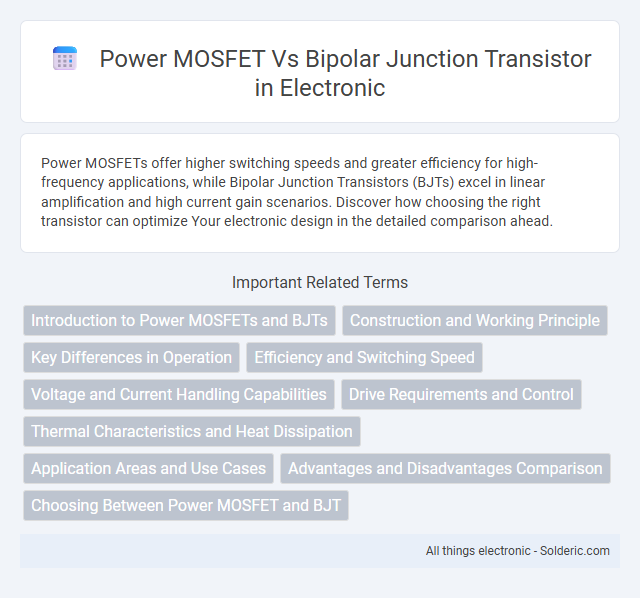Power MOSFETs offer higher switching speeds and greater efficiency for high-frequency applications, while Bipolar Junction Transistors (BJTs) excel in linear amplification and high current gain scenarios. Discover how choosing the right transistor can optimize Your electronic design in the detailed comparison ahead.
Comparison Table
| Feature | Power MOSFET | Bipolar Junction Transistor (BJT) |
|---|---|---|
| Type | Voltage-controlled device | Current-controlled device |
| Input Resistance | High (megaohms) | Low (hundreds of ohms) |
| Switching Speed | Fast switching, suitable for high-frequency | Slower switching speed |
| On-State Voltage Drop | Low R_DS(on), low voltage drop | Higher voltage drop (V_CE(sat)) |
| Power Dissipation | Lower losses during conduction | Higher conduction losses |
| Drive Power | Needs minimal gate current | Requires significant base current |
| Thermal Stability | Positive temperature coefficient improves parallel operation | Negative temperature coefficient, less stable in parallel |
| Applications | High-speed switching, power supplies, motor controllers | Amplification, analog circuits, linear operation |
Introduction to Power MOSFETs and BJTs
Power MOSFETs utilize an insulated gate structure allowing fast switching and high efficiency in power electronics, making them ideal for low-voltage, high-frequency applications. Bipolar Junction Transistors (BJTs) rely on current-controlled junctions that provide high current gain and robustness, suited for high-voltage, high-current scenarios. Understanding the differences in gate control and conduction mechanisms helps you select the optimal transistor type for your power management needs.
Construction and Working Principle
Power MOSFETs utilize a metal-oxide-semiconductor structure with an insulated gate to control current flow through an n-channel or p-channel, enabling high-speed switching and low gate drive power. Bipolar Junction Transistors (BJTs) rely on current-controlled junctions with three layers--emitter, base, and collector--where charge injection between p-type and n-type regions modulates the device's conductance. Your choice between these depends on the application's switching speed, efficiency, and voltage requirements, as MOSFETs offer voltage-driven control while BJTs require continuous base current.
Key Differences in Operation
Power MOSFETs operate using voltage-controlled channels that allow electrons to flow through an insulated gate, resulting in high switching speed and efficiency. Bipolar Junction Transistors (BJTs) rely on current-controlled junctions that involve both electron and hole movement, leading to higher gain but slower switching speeds. The inherent structure of MOSFETs provides lower on-resistance and better thermal stability compared to BJTs, which are more susceptible to thermal runaway due to their current-driven operation.
Efficiency and Switching Speed
Power MOSFETs exhibit higher efficiency and faster switching speeds compared to Bipolar Junction Transistors (BJTs) due to their majority carrier operation, resulting in lower switching losses and reduced gate drive power requirements. While BJTs suffer from charge storage effects that limit switching speed and efficiency, MOSFETs can switch at higher frequencies, making them ideal for high-speed power electronics applications such as DC-DC converters and motor drives. The low on-resistance (R_DS(on)) of Power MOSFETs further enhances efficiency by minimizing conduction losses during operation.
Voltage and Current Handling Capabilities
Power MOSFETs excel in high-voltage applications, typically handling voltages from 20V up to 1000V or more, with fast switching speeds and low on-resistance, making them ideal for efficient power conversion. Bipolar Junction Transistors (BJTs) can operate at high current densities and are often preferred in applications requiring robust current handling, with typical currents ranging from a few amps to several tens of amps, though they have slower switching speeds and higher voltage drops compared to MOSFETs. Your choice depends on whether voltage endurance or current capacity is more critical for your specific circuit requirements.
Drive Requirements and Control
Power MOSFETs feature voltage-driven gates requiring minimal input current to switch states, making them highly efficient for fast switching applications and easier to control with low-power signals. Bipolar Junction Transistors (BJTs), on the other hand, demand continuous base current to maintain conduction, leading to higher drive power consumption and more complex biasing circuits. Your choice between these devices should consider the ease of drive circuitry and power efficiency critical to your application's control system.
Thermal Characteristics and Heat Dissipation
Power MOSFETs exhibit lower thermal resistance and faster switching capabilities, resulting in more efficient heat dissipation compared to Bipolar Junction Transistors (BJTs). BJTs tend to have higher junction temperatures due to their higher conduction losses and slower switching speeds, leading to increased thermal stress. Effective thermal management in power MOSFETs enhances reliability in high-frequency applications, making them preferable for heat-sensitive designs.
Application Areas and Use Cases
Power MOSFETs excel in high-speed switching applications such as power supplies, motor drives, and DC-DC converters due to their low gate drive power and fast switching capabilities. Bipolar Junction Transistors (BJTs) are preferred in linear amplification, audio equipment, and high-current applications where high gain and robustness under thermal stress are critical. Your choice depends on the specific requirements of switching speed, efficiency, and amplification within the intended application area.
Advantages and Disadvantages Comparison
Power MOSFETs offer faster switching speeds and higher efficiency due to low gate charge and input capacitance, making them ideal for high-frequency applications. Bipolar Junction Transistors (BJTs) provide higher current density and better performance in linear amplification but suffer from slower switching and higher power dissipation. While MOSFETs excel in low-voltage and high-speed circuits, BJTs remain advantageous for handling higher voltage and current in analog domains, highlighting a trade-off between switching efficiency and load capacity.
Choosing Between Power MOSFET and BJT
Power MOSFETs offer faster switching speeds and higher efficiency in low-voltage, high-frequency applications, making them ideal for power supplies and DC-DC converters. Bipolar Junction Transistors (BJTs) provide better performance in high-current, low-frequency environments due to their higher gain and thermal stability. Selecting between a Power MOSFET and BJT depends on specific requirements such as switching speed, voltage rating, current capacity, and thermal management.
Power MOSFET vs Bipolar Junction Transistor Infographic

 solderic.com
solderic.com